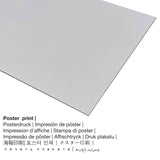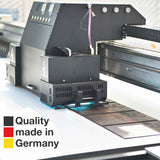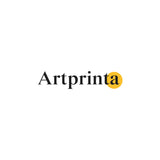Eva Bonnier, 1886 - Interior of a Studio in Paris - fine art print
Tax included. Shipping calculated at checkout.
Artwork information by the museum's website (© - Nationalmuseum Stockholm - www.nationalmuseum.se)
English: Eva Bonnier was one of many Swedish women artists who studied and worked in Paris in the 1880s. This painting shows a corner of the studio she rented in Montparnasse in 1885–1887. A boy’s head in clay is on the modeling stand. Bonnier was active mainly as a portrait painter. She herself has said that she made the sculpture when she needed a change from painting. The model was described in a letter home as “a little urchin, and therefore not inclined to sit still, but from an Italian family of models”. Eva Bonnier har i bilden på ett förunderligt sätt lyckats gestalta det blåskimrande ljuset som sprider sig in i rummet och över skulpturen av den unga pojken. I flera av hennes målningar från Paris har hon som här skildrat den egna ateljén på Rue Humboldt i Montparnasse. Bonnier bodde i Paris mellan 1883-1889. Hon studerade vid Académie Colarossi och ställde ut både 1887 och 1888 på Paris-salongen. Bilden är en av Eva Bonniers mest fria kompositioner, i breven hem framgår det att hon betraktade arbetet med skulpturen som omväxling från det tidskrävande målandet, något som hon kunde förhålla sig fritt till utan sina egna och bokförläggarfamiljen Bonniers högt ställda ambitioner. I de andra bilderna osynliggör hon det egna konstnärskapet, alla dukar är vända in mot väggen, det finns inga antydningar om att det är just hennes arbetsplats. I hennes konstnärliga produktion finns det överlag ett förnekande av det egna konstnärskapet vilket till slut ledde till att hon upphörde att måla. Eva Bonnier och många av hennes kvinnliga kollegor hade problem med sin yrkesidentitet. Viljan att skapa konst uppfattas som faderlig under ett patriarkat och så länge patriarkatet betraktas som natur är det ”onaturligt” och ”okvinnligt” för en kvinna att vara konstnär. Men redan 1864 öppnade Qvinliga afdelningen på Konstakademien i Stockholm. Bonnier hade själv först fått sin utbildning på August Malmströms konstskola och sedan på Konstakademien 1878 – 1883. De kvinnliga konstnärerna i Sverige var därmed privilegierade jämfört med sina europeiska systrar, som var helt utestängda från konstakademierna och förbjudna att arbeta med nakenmodeller. Kring 1880 fanns det enbart i Norden, tack vare den gryende kvinnofrigörelsen, flera hundra kvinnliga konstnärer och författare. De yrkesverksamma kvinnorna tog och fick mycket utrymme i det offentliga konstlivet. De förändrade tidens syn på både konstnärsrollen och det borgerliga familjelivet. De rubbade därmed tidens syn på kön och den manliga konstnärsnormen kom i gungning. På 1890-talet kom det en motreaktion, en backlash.
Background information on the unique artpiece
| Title of the artwork: | "Interior of a Studio in Paris" |
| Categorization of the artpiece: | painting |
| Umbrella term: | modern art |
| Period: | 19th century |
| Year of creation: | 1886 |
| Age of artwork: | 130 years old |
| Original artwork dimensions: | Height: 41 cm (16,1 ″); Width: 32 cm (12,5 ″) Framed: Height: 44 cm (17,3 ″); Width: 35 cm (13,7 ″); Depth: 1,5 cm (0,5 ″) |
| Museum / location: | Nationalmuseum Stockholm |
| Museum location: | Stockholm, Stockholm County, Sweden |
| webpage Museum: | www.nationalmuseum.se |
| Artwork license type: | public domain |
| Courtesy of: | Nationalmuseum Stockholm & Wikimedia Commons |
Artist overview
| Name: | Eva Bonnier |
| Gender: | female |
| Artist nationality: | Swedish |
| Professions of the artist: | painter |
| Country of origin: | Sweden |
| Artist classification: | modern artist |
| Died at the age of: | 52 years |
| Year born: | 1857 |
| Hometown: | Stockholm |
| Year of death: | 1909 |
| Deceased in (place): | Copenhagen |
Structured product details
| Product type: | art copy |
| Method of reproduction: | reproduction in digital format |
| Production process: | UV print / digital printing |
| Production: | German production |
| Type of stock: | on demand production |
| Product use: | art collection (reproductions), wall decoration |
| Alignment: | portrait alignment |
| Side ratio: | 3 : 4 - length : width |
| Side ratio meaning: | the length is 25% shorter than the width |
| Product material options: | metal print (aluminium dibond), acrylic glass print (with real glass coating), poster print (canvas paper), canvas print |
| Canvas print (canvas on stretcher frame) options: | 30x40cm - 12x16", 60x80cm - 24x31", 90x120cm - 35x47", 120x160cm - 47x63" |
| Acrylic glass print (with real glass coating): | 30x40cm - 12x16", 60x80cm - 24x31", 90x120cm - 35x47", 120x160cm - 47x63" |
| Poster print (canvas paper) size options: | 30x40cm - 12x16", 60x80cm - 24x31", 90x120cm - 35x47" |
| Dibond print (alumnium material) sizes: | 30x40cm - 12x16", 60x80cm - 24x31", 90x120cm - 35x47" |
| Framing of the art reproduction: | not included |
Your product material choices
For every product we offer a range of different sizes & materials. The following sizes and materials are the options we offer you for individualization:
- Canvas: The printed canvas material stretched on a wooden frame. A canvas generates a special look of three-dimensionality. The canvas print creates a familiar and positive feeling. A canvas print has the advantage of being relatively low in weight. That means, it is easy to hang up the Canvas print without the help of any wall-mounts. Because of thatcanvas prints are suitable for all kinds of walls.
- Acrylic glass print: The acrylic glass print, often described as a print on plexiglass, will convert your favorite original artwork into beautiful décor. In addition, it offers a great alternative option to dibond and canvas fine art replicas. Your own version of the artwork is being made thanks to state-of-the-art UV printing technology. The major benefit of an acrylic glass print is that contrasts plus granular details become more visible thanks to the fine tonal gradation of the picture. The real glass coating protects your selected art print against light and external influences for between 40-60 years.
- The poster print on canvas material: The poster is a UV printed flat canvas paper with a granular surface structure. Please keep in mind, that depending on the size of the canvas poster print we add a white margin of approximately 2-6cm around the print motif to facilitate the framing with a custom frame.
- Aluminium dibond print (metal): These are metal prints on aluminium dibond with an impressive depth effect. The non-reflective surface structure creates a contemporary look. For the Direct Aluminium Dibond print, we print your chosen artpiece onto the aluminium composite surface. The colors are bright and luminous in the highest definition, the fine details are clear and crisp, and the print has a a matte look that you can literally feel. The direct print on Aluminum Dibond is the most popular entry-level product and is an extremely contemporary way to display fine art reproductions, since it draws attention on the replica of the artwork.
Art product specs
The modern art artwork was made by the artist Eva Bonnier. The version of the piece of art has the following following dimensions: Height: 41 cm (16,1 ″); Width: 32 cm (12,5 ″) Framed: Height: 44 cm (17,3 ″); Width: 35 cm (13,7 ″); Depth: 1,5 cm (0,5 ″). Nowadays, the artpiece belongs to the art collection of Nationalmuseum Stockholm. With courtesy of - Nationalmuseum Stockholm & Wikimedia Commons (public domain license).Creditline of the artwork: . On top of that, alignment is in portrait format and has an aspect ratio of 3 : 4, which means that the length is 25% shorter than the width.
Important legal note: We try our utmost to describe our products as closely as possible and to showcase them visually in our shop. However, some colors of the print materials, as well as the print result might diverge marginally from the representation on the monitor. Depending on the screen settings and the nature of the surface, not all color pigments can be printed as exactly as the digital version shown here. Since our art reproductions are processed and printed by hand, there might also be slight deviations in the exact position and the size of the motif.
© Copyright of, Artprinta.com (Artprinta)














